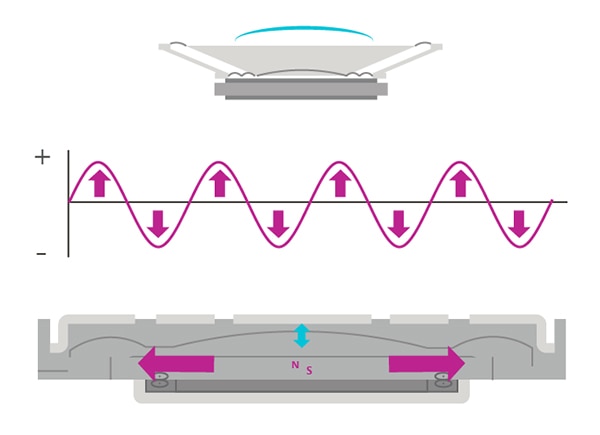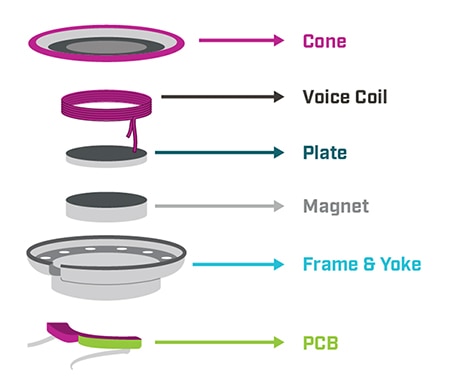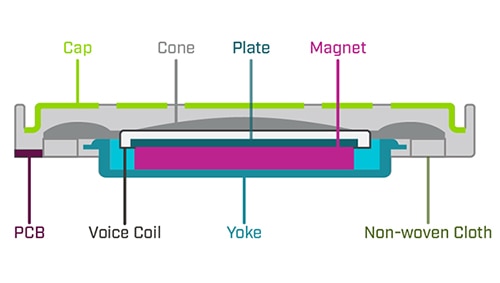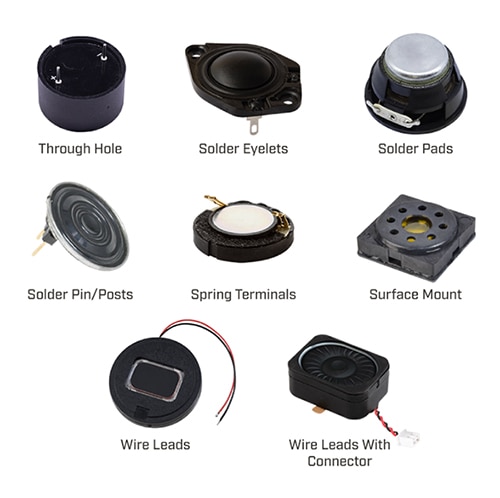完整的扬声器选型指南
2024-09-16
扬声器是将电信号转换为用户可听到的声波的换能器,是音频系统中的重要部件。要充分了解扬声器在声音再现过程中的作用,就必须探究其工作背后的工程原理和所涉及的关键部件。本文详细介绍扬声器技术,包括基本工作原理、重要规格、设计注意事项、音盆和磁铁类型等。
扬声器基础知识
扬声器发出声音是一个精心设计的过程,利用了电磁学和机械运动的原理。一切从电信号开始,电信号代表了需要再现的音频内容。这种信号可能来自各种不同的源头,如智能手机、笔记本电脑或任何其他旨在产生电脉冲的音频设备。无论是歌曲旋律、播客清晰度,还是电影身临其境的效果,这种信号都是扬声器即将创造出的听觉体验的电气蓝图。
扬声器的核心部件是音圈和永磁体。音圈通常是紧密缠绕的导线,与柔性音盆或振膜相连。这个线圈内部环绕着一块永久磁铁,建立了声音产生的核心。当电信号通过扬声器的导线时,音圈通电,在电磁力的驱动下产生一系列动作。电流在线圈周围产生磁场,磁场的极性随电信号的变化而变化。
扬声器的运动取决于这些磁场之间的相互作用。随着电场的波动,它们交替地排斥和吸引,导致音圈及其附带的音盆快速来回移动。音盆的振荡运动与周围的空气分子相互作用,使它们随着音盆的运动而振动。
这些振动在空气中产生压力波,压力波会一直传播到人的耳朵,大脑将其解读为声音。这就完成了声音感知过程,将电信号转化为丰富的听觉体验。
 图 1:扬声器的工作原理。(图片来源:Same Sky)
图 1:扬声器的工作原理。(图片来源:Same Sky)
通过对扬声器结构的研究,我们可以发现几个共同作用产生声音的关键部件:音盆、音圈、音板、磁铁、框架和轭以及印刷电路板 (PCB)。以下插图重点说明了扬声器在拆卸(图 2)和组装(图 3)状态下的内部结构。
 图 2:扬声器组件的分解视图。(图片来源:Same Sky)
图 2:扬声器组件的分解视图。(图片来源:Same Sky)
 图 3:扬声器组件的装配视图。(图片来源:Same Sky)
图 3:扬声器组件的装配视图。(图片来源:Same Sky)
扬声器的重要规格和注意事项
对扬声器的工作和结构有了基本了解后,选择扬声器时的重要考虑事项就是几个关键的规格和性能标准。这些参数对于确保扬声器能否达到所需的音频性能和可靠性标准至关重要。
- 声压级 (dB):声压级 (SPL) 量化了空气中的声波强度,其本质上表示响度。与声源的距离和环境条件都会影响声压级。分贝 (dB) 是衡量声压级的标准单位。对于扬声器设计、各种环境下的噪音水平评估来说,了解声压级极为重要,这是噪音控制和监管的关键。
- 最大输入功率 (W):此规格表示扬声器在不出现永久性损坏的情况下短时间内可承受的最大功率。
- 标称输入功率 (W):标称输入功率指扬声器在长期连续运行时能够承受的安全功率。这是确保扬声器在正常工作条件下的长使用寿命和高可靠性的关键。
- 阻抗 (Ω):用于测量电流从放大器流向扬声器的电阻。阻抗越低,扬声器的功率就越大,因此扬声器的阻抗必须与放大器的阻抗相匹配。正确的阻抗匹配对于实现最佳性能、高效功率传输、保持高保真声音重现以及防止设备损坏极为关键。
- 谐振频率 (Hz):这是扬声器的最有效振动频率,有助于深度了解扬声器的低频响应。了解谐振频率有助于比较不同扬声器的性能,尤其是低频性能。
- 尺寸 (mm):扬声器的尺寸直接影响其频率范围。尺寸较小的扬声器针对较高频率进行了优化,而较大的扬声器则在较低频时表现更佳。在为诸如深沉的低音或清晰的中频人声等特定音频输出设计系统时,这种关系是关键。
- 总 Q 值:Thiele-Small 参数(即总 Q 值)用作为扬声器选择理想箱体类型的广泛基准值。如果总 Q 值为 0.4 或更低,则表示扬声器最适合安装在通风的箱体中。数值在 0.4 和 0.7 之间表示建议使用密封箱体,而 0.7 或更高则表示扬声器适合自由空气、半开放式背板或无限隔板设置。然而,这些准则并不是绝对的,重要的是要考虑设计中的所有相关参数,以达到理想的音频性能。
- 侵入防护 :扬声器具有各种不同的侵入防护 (IP) 等级,以应消除恶劣环境中的湿气和污染物的影响。
- 安装方式:根据应用需要,扬声器可采用不同的连接方式,包括通孔、电线引线、弹簧端子等。
 图 4:常用的扬声器连接配置。(图片来源:Same Sky)
图 4:常用的扬声器连接配置。(图片来源:Same Sky)
扬声器的测量和测试
在按照上文提到的主要规格选择扬声器后,还必须测量和测试,以确保扬声器能正确地集成到设计中,并发挥预期的性能。Same Sky 的音频设计服务将为这些关键的测量和测试提供支持:
- 频率响应:扬声器对全频段声音的再现程度的可视化。Same Sky 关于音频范围和谐振频率的两篇博文较详细地讨论了频率响应图。
- 阶跃频率扫描:针对假频进行更详细的频率响应分析。
- 电平和增益:决定扬声器的能量输出能力。测量方法是将设备的输出电平除以输入电平。
- 总谐波失真加噪声 (THD+N):当在音频信号中加入了不需要的音调时,就会产生谐波失真,从而降低音质。THD+N 是一个用单一数字表示的性能指标,已被广泛理解和接受。
- 相位:描述波形与基准信号之间的时间偏移。音频设计中的两种主要相位测量是设备输入/输出相位和通道间相位,后者可确保系统中多个扬声器之间的正确同步。
- 摩擦和嗡嗡声:检测低频刺激产生的高频谐波产品,有助于识别造成不必要噪音的缺陷。
- Thiele-Small 参数:这组测量可捕捉被测扬声器的复合阻抗,并提供决定扬声器低频性能的机电参数。Thiele-Small 参数(包括总 Q 值)对于扬声器箱体设计和生产测试至关重要,因为这些参数描述了扬声器与箱体的相互作用方式。
- 阻抗:测量扬声器的阻抗对于了解扬声器对交流信号流动的阻力非常重要,如来自放大器的音频信号。阻抗以欧姆为单位,会影响扬声器从放大器汲取的功率大小,以及扬声器的工作效率。
扬声器的音盆和磁铁类型
扬声器振膜的材料对音质有很大影响。数据固然有用,但倾听和测试才是关键。耐用性因材料而异:塑料最耐用,其次是纸和布,然后是泡沫塑料。使用寿命还取决于湿度、环境和应用。以下是常见音盆材料的汇总:
- 塑料:经久耐用,防尘防水,精确的制造公差可减少失真,提高音质。成本因厚度和生产工艺而不同。
- 纸和布料:具有良好的声音和自阻尼,但会受湿度影响。这些材料由木质纤维和添加剂制成,由于重量轻,通常用于大型扬声器。
- 泡沫:泡沫很少单独使用,与金属或纸张等材料结合在一起,可增强内部损耗,使声音更加自然。
磁铁类型也是影响扬声器结构和性能的关键因素。下面总结了扬声器中最常用的磁铁类型:
- 铁氧体:成本低,耐用,耐腐蚀,但重量大,不适合便携式使用。铁氧体在接近最大容量时性能良好。
- AlNiCo:音色经典,不易开裂,但价格较高。如今,已较少使用,见于高端应用。
- 钕 (NdFeB):重量轻,磁场强度高,是小型高 SPL 扬声器的理想选择。这种材料具有良好的频率响应性,但易碎。
- 钐钴:价格昂贵,但具有出色的耐腐蚀性和温度稳定性。这种材料的强度较低,易碎。
结束语
了解扬声器的机械结构有助于工程师创造身临其境般的音频体验。本文重点介绍了选择合适扬声器时涉及到的各种部件和规格。不过,即使牢记这些参数,也必须对最终设计进行全面的测试和测量。为此,Same Sky 推出一系列微型和标准扬声器以及音频设计服务。
免责声明:各个作者和/或论坛参与者在本网站发表的观点、看法和意见不代表 DigiKey 的观点、看法和意见,也不代表 DigiKey 官方政策。









